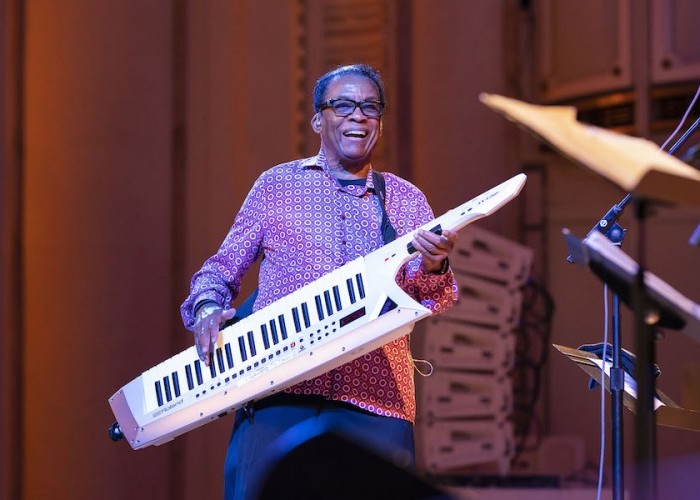Apr 2, 2024 12:59 PM
Saxophonist, Sonic Explorer Casey Benjamin Dies at 45
Casey Benjamin, the alto saxophonist, vocalist, keyboardist and producer who stamped his distinctive sounds on the…

Herbie Hancock, and his keytar, drew standing ovations during his Chicago homecoming concert.
(Photo: Clay Baker)As Herbie Hancock demonstrated in his recent return to performance, he is a musician of multitudes. The youthful 81-year-old NEA Jazz Master, UCLA professor, chair of the Herbie Hancock Institute of Jazz and UNESCO Good Will Ambassador for Intercultural Dialogue packed both his live-in-person quintet concert at Chicago’s Symphony Center on Sept. 2 (and the Detroit Jazz Festival show the next night, streamed rather than held in public as had been planned) with compositions, improvisations, keyboard investigations, artistic concepts and the leadership style he’s developed in a career spanning at least 60 years. His U.S. tour continues through the month.
In Chicago, an eerie, free-form episode that suggested Hancock’s early 1970s Mwandishi ensemble was the opener; in Detroit, Hancock made time to play “Windows” in dedication to his late “life-long best friend” and colleague Chick Corea. Otherwise, the set lists were similar, with in-the-moment variations of interpretation.
Sitting between two electric instruments and a Fazioli grand piano with his keytar nearby, Hancock switched among his voices and styles quickly, as if trying to fit them all in. He evoked the enduring quality of his 1960s Blue Note beginnings with the evergreen “Cantaloupe Island” and his funk-fusion pre-eminence with his hit “Chameleon,” arranged to sound like now, not then. After setting up themes on electric gear with his front line in closely focused voicings, and syncing with the rhythm team’s pocket, he frequently swiveled to play rich and driving chords on the grand. The mix of electric and acoustic instruments is often problematic, and in Symphony Center some piano nuances were lost in the overall sound, but viewed by a closeup camera online, Hancock’s harmonic sophisticated and finger fleetness stood out clearly.
Ever sensitive to musicians on the rise, Hancock arranged “Absolute Proof” as a set-piece featuring the soloistic talents of his guitarist-vocalist Lionel Loueke, flutist-vocalist Elena Pinderhughes, electric bassist James Genus and drummer Justin Tyson (who hit his kit hard, with tall baffles between him and his leader). Miles Davis spotlit Hancock, Wayne Shorter, Ron Carter and Tony Williams during their years in his employ with an air of diffidence; Herbie in contrast is vocal in his pride for his younger band members and generous in his accompaniment to them.
Loueke sang in an African language of his native Benin and scatted playfully in addition to showing off his clipped and/or beady processed guitar sounds. Pinderhughes’ flute rode the treble lines tightly, her flute contributions virtuosic, her intonation so focused as to bear no hint of breath behind it. One climax of the Chicago event was her trading of fours with Hancock standing next to her, stage front, wielding his keytar.
Hancock, born and raised in Chicago, where he was recognized as a prodigy, is clearly still enthusiastic about the instruments whose uses he pioneered. Besides his strap-held ax and various synths, he offered up one tune on vocoder. Aficionados of one facet or another of his career might carp they didn’t hear enough “Watermelon Man” or “Maiden Voyage,” “Future Shock,” anything from Speak Like A Child or Gershwin’s World or The Joni Letters. But this is a typical issue for artists trying to represent their many decades of original explorations in 90 or 120 minutes. Herbie Hancock’s audiences seem to be generally understanding about the problem, and unconcerned. In Chicago, he was greeted with a standing ovation and rewarded with the same at the concert’s end. DB

Benjamin possessed a fluid, round sound on the alto saxophone, and he was often most recognizable by the layers of electronic effects that he put onto the instrument.
Apr 2, 2024 12:59 PM
Casey Benjamin, the alto saxophonist, vocalist, keyboardist and producer who stamped his distinctive sounds on the…

“He’s constructing intelligent musical sentences that connect seamlessly, which is the most important part of linear playing,” Charles McPherson said of alto saxophonist Sonny Red.
Feb 27, 2024 1:40 PM
“I might not have felt this way 30 to 40 years ago, but I’ve reached a point where I can hear value in what people…

Albert “Tootie” Heath (1935–2024) followed in the tradition of drummer Kenny Clarke, his idol.
Apr 5, 2024 10:28 AM
Albert “Tootie” Heath, a drummer of impeccable taste and time who was the youngest of three jazz-legend brothers…

“Both of us are quite grounded in the craft, the tradition and the harmonic sense,” Rosenwinkel said of his experience playing with Allen. “Yet I felt we shared something mystical as well.”
Mar 12, 2024 11:42 AM
“There are a few musicians you hear where, as somebody once said, the molecules in the room change. Geri was one of…

Henry Threadgill performs with Zooid at Big Ears in Knoxville, Tennessee.
Apr 9, 2024 11:30 AM
Big Ears, the annual four-day music celebration that first took place in 2009 in Knoxville, Tennessee, could well be…